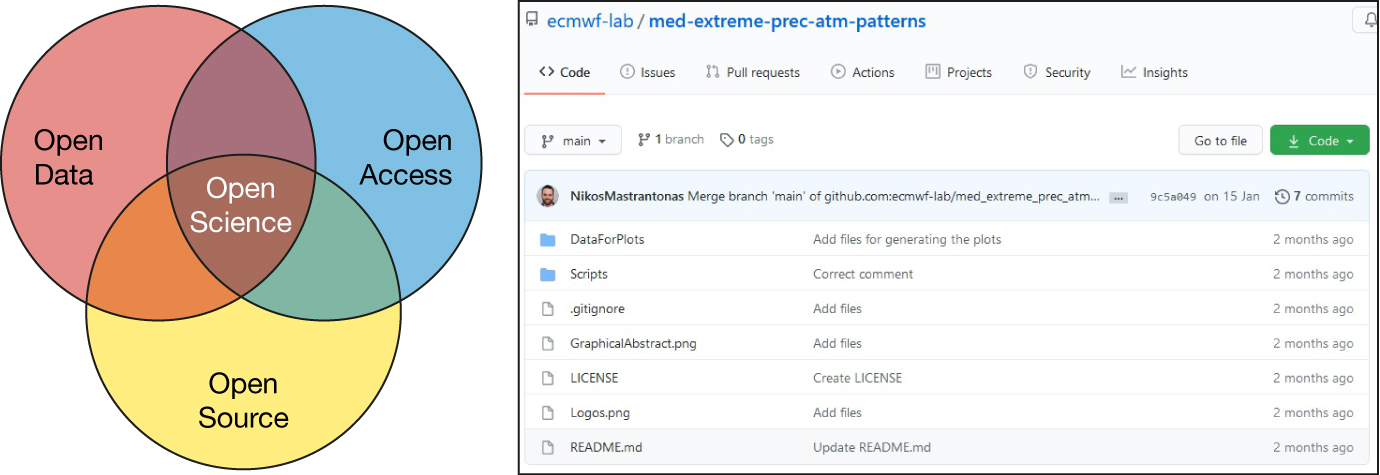Following a recent publication, this article presents some complementary actions that we took to make the work more accessible to interested users and researchers in the interest of ‘open science’.
Sharing science
Scientific publications are crucial for expanding our knowledge. A stand-alone publication nevertheless withholds many aspects of the work from its readers. This is why many researchers and institutes shift towards open science. It means that they make publicly available additional elements that led to the publications, such as the data and the tools developed.
A recent publication about extreme precipitation in the Mediterranean (https://doi.org/10.1002/joc.6985) follows a similar path. The work analysed the spatiotemporal characteristics of extreme precipitation events for regions across the Mediterranean and quantified their connections to large-scale atmospheric flow patterns over the entire domain. Bearing in mind that it could be of interest to many researchers as well as users from our Member and Co‑operating States, the idea was to move a step further from the (open-access) peer-reviewed publication. In a move towards open science, this work uses freely accessible datasets and software and provides online all the post-processed data and the scripts developed for the analysis.
Motivation
The motivation behind these additional initiatives is threefold. First, sharing tools and data can support research tackling similar topics. We also want to encourage more scientists to implement similar methods and strengthen the already remarkable efforts within the Earth science community for open and accessible science. Finally, by making the work publicly available we are hoping to get valuable feedback from interested users. This feedback can help to further improve the practices used and optimise the analysis. In a nutshell, every contribution towards open science supports the collective efforts of the scientific community and gives the opportunity to improve our individual skills and competences.
Data & tools used
As part of the Copernicus programme, ECMWF provides ERA5, the latest state-of-the-art reanalysis dataset of very high spatiotemporal resolution. The analysis conducted as part of the research on extreme precipitation in the Mediterranean made use of this dataset, which is freely accessible within the Copernicus Climate Data Store. We also used the Python software, a free and open-source programming language with an extensive community of developers. All the scripts for processing the data and creating the figures were written with Python in the Jupyter notebooks environment, which is easy to use by others and provides an opportunity to accompany the code with figures and explanatory text. All notebooks and post-processed data are available via a repository within the ECMWF account in GitHub (https://github.com/ecmwf-lab/med_extreme_prec_atm_patterns). Anyone can freely access this repository, download its content and reproduce the results locally. More importantly, any users can modify subsections of the workflow and adjust it to their needs and interests.

Open science at ECMWF
This work is only one of many contributions to open science within ECMWF. There are many efforts to make our science more accessible, share workflows and data with the scientific community, and provide tools to the end users. However, just publishing open articles and opening up the data is not enough if only scientists from our domain can use it. The development of open-source software packages that facilitate the use of weather and climate data (such as Metview and ecCodes) and computational routines used on ECMWF’s operational products (such as the Integrated Forecasting System) are steps in the right direction. Making the data accessible in a wider open-source software ecosystem by developing the Python interface in Metview, and the cfgrib library for the Python and Julia languages, makes it possible for our data to be used by a much wider audience than meteorological and climatological scientists. All the above are freely accessible by all interested users. The workshop ‘Building reproducible workflows for earth sciences’, organised by ECMWF in 2019 (https://events.ecmwf.int/event/116/), provides a small summary of many of these initiatives towards open science.

